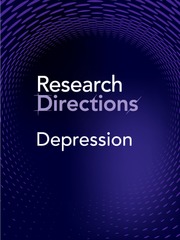Context
The most basic distinction between depressive (and other mood) disorders and other major mental disorders is the notion that they are primarily mood or affective disorders and not fundamentally perturbations of other cognitive, perceptual, motor, communication, impulse, sleep−wake, fear-response, arousal, developmental or personality functions. The primacy of mood or affective state is captured in the ‘core’ criteria for major depression (depressed mood or loss of pleasure) and the other major mood disorders (e.g., for dysthymia – prolonged depressed mood) (American Psychiatric Association, 2013). For bipolar disorder, while the presence of manic features (with increased motor activity) (Scott et al., Reference Scott, Murray, Henry, Morken, Scott, Angst, Merikangas and Hickie2017) is the core element, the depressive phase is described in similar terms, with the emphasis on the same shared features of major depression (i.e., depressed mood or loss of pleasure).
An alternative view of the central features of at least some sub-types of depressive disorders, including major or clinical depression, melancholia, atypical depression, circadian depression or the depressed phase of bipolar disorder, is that the essential feature is not affective but rather a change in energy state and related motor functions (Angst et al., Reference Angst, Gamma, Sellaro, Zhang and Merikangas2002; Parker and Hadzi-Pavlovic, Reference Parker and Hadzi-Pavlovic1996). These differences do not simply correlate with depression severity but rather are assumed to reflect potential differences in underlying neurobiological or pathophysiological mechanisms.
The behavioural characteristics of these mood disorders are observed (or recorded independently as) being increases or decreases in observed motor activity, as well as uncoupling of the pattern of that activity from variations in the normal diurnal or 24 hour light-dark cycle (Carpenter et al., Reference Carpenter, Crouse, Scott, Naismith, Wilson, Scott, Merikangas and Hickie2021; Merikangas et al., Reference Merikangas, Swendsen, Hickie, Cui, Shou, Merikangas, Zhang, Lamers, Crainiceanu, Volkow and Zipunnikov2019). The key subjective features relate to reports of increased or decreased energy, again uncoupled with variations in the normal diurnal or 24 hour light-dark cycle (Crouse et al., Reference Crouse, Carpenter, Song, Hockey, Naismith, Grunstein, Scott, Merikangas, Scott and Hickie2021).
This differentiation of reported mood states from these other observed motoric or reported energy states leads to quite divergent views as to the underlying neurobiology (with much greater emphasis on cortical-subcortical motor circuitry, dopaminergic biochemistry, mitochondrial function, relationships to circadian biology and sleep−wake cycles), developmental and evolutionary aspects (e.g., shared characteristics with factors such as seasonally driven migration patterns and hibernation) states of social and environmental context (e.g., relationships to seasonality, light exposure, motor activity) and choice of treatments (i.e., efficacy of interventions that regulate motor activity, 24 hour activity patterns).
To advance this field, a focus on methods that actively record these subjective energy states and objective motoric behavioural patterns is required. It has the capacity to support the differentiation of some mood disorder sub-groups from other potential subtypes, predict the ways in which they may influence longitudinal course and permit exploration of the extent to which therapeutic options focused on these phenomena improve outcomes.
How to contribute to this Question
If you believe you can contribute to answering this Question with your research outputs find out how to submit in the Instructions for authors (https://www.cambridge.org/core/journals/research-directions-depression/information/author-instructions/preparing-your-materials). This journal publishes Results, Analyses, Impact papers and additional content such as preprints and ‘grey literature’. Questions will be closed when the editors agree that enough has been published to answer the Question so before submitting, check if this is still an active Question. If it is closed, another relevant Question may be currently open, so do review all the open Questions in your field. For any further queries check the information pages (https://www.cambridge.org/core/journals/research-directions-depression/information) or contact this email (depression@cambridge.org).
Competing interests
The authors declare that there are no competing financial interests in relation to the work described. Potential conflicts of interest may arise from the following: IBH is the Co-Director, Health and Policy at the Brain and Mind Centre (BMC) University of Sydney. The BMC operates an early-intervention youth services at Camperdown under contract to headspace. He is the Chief Scientific Advisor to, and a 3.2% equity shareholder in, InnoWell Pty Ltd, which aims to transform mental health services through the use of innovative technologies. EMS is the Discipline Leader of Adult Mental Health, School of Medicine, University of Notre Dame; Research Affiliate, The University of Sydney and Consultant Psychiatrist. She has received honoraria for educational seminars related to the clinical management of depressive disorders supported by Servier and Eli-Lilly pharmaceuticals. She has participated in a national advisory board for the antidepressant compound Pristiq, manufactured by Pfizer. She was the National Coordinator of an antidepressant trial sponsored by Servier.





